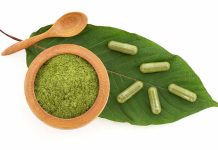Does Kratom also catch your attention? It’s no surprise – because of several kratom benefits, this organic substance has gained popularity, offering a unique experience to its users. However, as with any herb medicinal substance, it’s essential to find the right balance and not let its allure lead you astray.
So, If you’re looking for a guide to know how you can effectively wean off Kratom and reclaim your life, here is where you need to be. This article is anything but a guide about how long it takes to wean off of kratom, so make sure to make it to the end.
How To Tell It’s Time To Quit Kratom?
Before getting to wean off Kratom, it’s crucial to recognize the signs of dependence. As it can manifest through various symptoms, indicating that your usage has become problematic and may be negatively impacting your life. Here are some common signs:
Loss Of Control
You find it difficult to control your Kratom usage. Despite your intentions to cut back or quit, you find yourself using it regularly and in larger amounts.
Unsuccessful Attempts To Quit
You have made several unsuccessful attempts to quit or reduce your use. However, the dependency on Kratom makes it challenging to break free from its grip.
Interference With Life
Your dosage starts affecting various aspects of your life, such as relationships, friendships, work, or school. It hinders your ability to function optimally in daily activities.
Continued Use Despite Awareness
Despite being aware of the negative consequences and potential dangers of excessive use, you continue to consume it or play with dosage and test your limits. In short, even after knowing that you must stop, you do not avoid using it.
Physical Symptoms
Kratom addiction may result in various physical symptoms too. Kratom side effects may range from heart palpitations, intense hunger pangs, dry mouth, memory loss, red eyes, anxiety, choking sensation, or nausea.
Emotional And Behavioral Changes
As far as the emotional symptoms are concerned, dependence on the herb can lead to mood swings, irritability, agitation, and increased aggression. So, in short, your emotional well-being may be negatively affected.
Fear Of Abstinencef
The thought of going without Kratom for even a few days makes you feel nervous or anxious. The fear of withdrawal symptoms may contribute to continued use.
Appetite And Weight Changes
Kratom addiction can cause a significant loss of appetite, leading to weight loss and potential nutritional deficiencies.
Creating A Weaning-Off Plan
The process of weaning off recreational Kratom requires a well-thought-out and gradual approach. Why is that so? Because if you stop abruptly, there can be consequences in the form of withdrawal symptoms, and it can be difficult to stay on track. Thus, to increase your chances of success, follow these detailed instructions:
Evaluate Your Current Usage: You can start by assessing your current usage. Keep a record of how much you consume, how often, and the times of day when you typically use it. In fact, understanding your usage routine will help you determine the starting point for your weaning plan.
Set Clear and Realistic Goals: Determine your ultimate goal for quitting. It could be complete abstinence or reducing your usage to a minimal, manageable level. Set SMART goals, which mans they need to be measurable, achievable, relevant, and time-bound (SMART).
Create a Gradual Reduction Schedule: Once you have set your goals, devise a gradual reduction schedule. Start by reducing your daily dosage by a small percentage. For example, if you consume ten grams of Kratom per day, consider reducing it by one or two grams every week.
Maintain Consistency: Consistency is crucial for a successful weaning plan. Stick to your schedule and avoid deviations to ensure steady progress toward your goal. Keep track of your daily intake and adjust the reduction accordingly.
Observe and Address Withdrawal Symptoms: As you start reducing your intake, don’t worry if you experience mild withdrawal symptoms. They can include anxiety, restlessness, irritability, and mild physical discomfort. In fact, now that you know what these effects can be, be prepared for them and find healthy coping mechanisms to manage them.
Seek Support and Accountability: Share your plan with a family member, a trusted friend, or a support group. Having someone who can hold you by the collar and provide encouragement during challenging times can make a significant difference in your success.
Modify the Plan as Needed: Everyone’s journey is unique, and what works for someone may not work for you. Be open to modifying your weaning plan if necessary. If you encounter difficulties or find the process too fast or slow, adjust the schedule accordingly.
Practice Self-Compassion: Weaning off Kratom is a challenging process, and setbacks are normal. If you slip up and consume more than planned on occasion, be compassionate with yourself and get back on track without self-judgment.
Reward Your Progress: Celebrate your milestones along the way. Whenever you successfully reduce your Kratom usage or achieve a mini-goal, reward yourself with something positive. This can keep you motivated and committed.
Be Patient and Persistent: Breaking free from Kratom dependency is not an overnight process. Be patient with yourself and stay persistent. Remind yourself of your reasons for quitting and stay focused on your goals.
By following this detailed weaning plan, you can create a structured approach to reduce and eventually eliminate recreational Kratom use gradually. Remember that seeking support, staying consistent, and being compassionate to yourself are vital elements of this journey. You have all the power to regain control over your life, so take on a healthier, Kratom-free future.
Adopt Healthy Habits
As you explore ways to wean yourself Off Kratom, adopting healthy habits is essential for a successful and sustainable recovery.
These habits will not only support your physical and emotional well-being but also serve as positive alternatives to the time you previously spent on Kratom. Follow these detailed guidelines to lead a healthier lifestyle:
Nutrition And Exercise
Focus on a Balanced Diet: You saw this coming, right? A well-balanced diet if you are fighting hard against your dependence. Also, make sure to stay hydrated.
Regular Exercise: Inculcate physical activity in your routine, such as walking, jogging, yoga, or swimming. Exercise boosts endorphins, improves mood, and helps reduce cravings.
Seek Support And Engage Socially
Join Support Groups: Consider joining support groups or online forums dedicated to individuals going through similar experiences. Connecting with others who understand your struggles can be empowering.
Mindfulness and Meditation:
Practice Mindfulness: Learn mindfulness techniques to stay present in the moment and reduce stress. Mindfulness can help you manage cravings and maintain focus on your recovery goals.
Meditation: Meditation is one very effective way to promote relaxation and mental clarity. In fact, regular meditation sessions will help you with your emotions, thought patterns, and excessive cravings.
Establish Healthy Sleep Patterns
Prioritize Sleep: Aim for 7-9 hours of quality sleep each night. Establish a bedtime routine to signal your body that it’s time to wind down and rest.
Explore New Hobbies and Interests:
Find Positive Diversions: Discover new hobbies or reignite old passions to fill the void left by Kratom. Engaging in fulfilling activities will reduce the temptation to turn to substances for stimulation.
Avoid Triggers And High-Risk Situations
Identify Triggers: Recognize situations, places, or people that may tempt you to use Kratom. Limit exposure to these triggers or develop strategies to cope with them effectively.
Make Lifestyle Changes: If certain environments or relationships contributed to your Kratom use, consider making lifestyle changes to protect your recovery.
Practice Self-Care and Stress Management:
Prioritize Self-Care: Dedicate time to self-care activities that promote relaxation and well-being. This can include taking warm baths, spending time in nature, or engaging in creative pursuits.
Manage Stress: Identify stressors in your life and develop healthy coping mechanisms to manage stress effectively. This could involve deep breathing exercises, journaling, or seeking professional counseling.
Conclusion
In conclusion, weaning off recreational Kratom or Mitragyna Speciosa is a courageous and transformative journey towards regaining control of your life.
Remember that progress may not always be simple, and setbacks are a natural part of the process. All you need to do is trust yourself and be patient and compassionate, celebrating every milestone along the way. Embrace positive changes in your lifestyle, prioritize self-care, and stay mindful of triggers to navigate the path to freedom successfully.
Frequently Asked Questions!
Can I quit Kratom cold turkey?
Quitting Kratom cold turkey can lead to severe withdrawal symptoms. Abruptly stopping Kratom use may cause physical and emotional discomfort, making it challenging to stay on track. Gradual reduction of dosage over time is generally recommended for a smoother and more manageable transition.
How long does Kratom withdrawal last?
The duration of Kratom withdrawal can vary significantly from person to person, making it challenging to provide a definitive answer. Based on user experiences and reviews, the withdrawal period typically ranges from several days to a few weeks. However, it’s important to note that individual factors can influence the length and intensity of withdrawal symptoms.
Is Kratom addictive?
Yes, prolonged and excessive use of Kratom can lead to dependence and addiction.
Where can I get support for quitting Kratom?
Professional counselors or addiction specialists can offer guidance and assistance throughout your journey to recovery.








